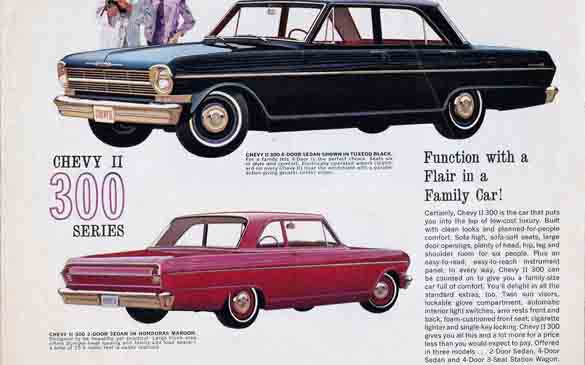
Building mainstream cars was a comfortable and profitable business for US mega brand Chevrolet until 1959. It rarely involved more than establishing an annual styling theme on an old school chassis powered by a six and V8, then capping it with as many different cabins and seating arrangements as the market could bear. As imports and rival compacts threatened to undermine this annual 1.5 million unit comfort zone, Chevrolet rushed the Chevy II to market in barely 18 months. As a 1962 release, it was Chevrolet's second counterstrike in two years and there was more to come.
There was no road map to counter the innovative, oddball imports. Should Detroit deliver a better version of the class-leading Volkswagen or distill what made their larger cars so popular into a smaller package? Chevrolet was the only company to do both, and the world was richer for it.
The 1960 Chevrolet Corvair delivered by Ed Cole was the first response and highlighted the pent-up talent inside GM waiting to be turned loose on a car that was genuinely different. Corvair styling was still influencing some models into the 1970s, the air-cooled flat-six pre-empted Porsche's shift to a flat-six and the four door family-sized body with an automatic option was a first for a rear-engined model. Intended to beat the Beetle at its own game, the $2103 Corvair could be legitimately regarded as an evolution of the Czech Tatra and the Tucker, both top shelf models.
Because Chevrolet bean counters had no experience with this unconventional engineering, they removed the handling safeguards that Cole and his team had specified for the suspension to rid the Corvair of the Beetle's shortcomings.
This not only left the Corvair with the Beetle's flaws but they were amplified by the extra weight and size. It was not enough to kill sales, yet, but it was a time bomb all the same. The big picture strategy worked as 1960 Chevrolet sales topped 1.6 million. Closer scrutiny however, showed that the Corvair's healthy 250,000 launch figure was a long way short of the Falcon's dominating 435,000.

Corvair sales peaked at 292,500 in 1962 and from there it was a steady decline. Ralph Nader added to that in 1965 with his "Unsafe at Any Speed" expose. Chevrolet had shown some foresight rushing the Chevy II into production as a back stop. Its 1962 debut sales of 327,000 climbed to 375,626 in 1963 exactly as Corvair sales started to slide to 254,600. These combined numbers were not only healthier than the Falcon but Chevrolet was holding its own against renewed competition from the Rambler American , a more mainstream Plymouth Valiant and a more stylish Studebaker Cruiser.
In the meantime, Ford had cleverly introduced the compact Fairlane in 1962 to give its Falcon buyers an aspirational choice. Although the Chevy II defined a useful compromise between the two, Chevrolet was forced to respond with the Chevelle in 1964, a Fairlane-sized model that revived 1955 middle-America's middle-sized car. Chevy II sales slipped back to 191,700 as the cheap and conventional entry level. The upside was the engineers could finally get their way with the Corvair as they transformed it into a budget enthusiast's choice, a transition cemented by the superb 1965 restyle under Ron Hill. For the first time, Chevrolet offered real choice for multi-car households.
This also left the Chevy II as the perfect starting point for a serious muscle car, even better than its Falcon and Valiant rivals. The Chevy II is often dismissed as a Chevrolet copy of a Falcon but there is more to it than that.
The Chevy II in Australia
It may have been Chevrolet's first front engine-rear drive monocoque but it wasn't as light and flimsy as the Falcon which caused so much grief in Australia. If Chevrolet needed a Falcon alternative then why didn't Holden and Chevrolet combine forces and build a shared model?
There are those who worked for Holden at the time who believe this was one of the options considered. They point to the 1963 EH Holden's new red engines as a left over from a process to build a Holden-sized Falcon rival. They recall Chevrolet engineering drawings which dictated a displacement of 149 and 179 cubic inches for the Holden engines that neatly capped the 144 and 170 Falcon engines.

The problem was that Chevrolet already had a Corvair with a 140cu in/2.3-litre six cylinder model on a 108inch/2743mm wheelbase. The EH Holden on its 105inch/2667mm wheelbase was too small and skinny to be a real alternative to the Corvair or rivals. Because the Falcon was mauling the Corvair, the Chevy II had to be seen as offering more from the start. Its 110inch/2794mm wheelbase was a half inch/12.7mm longer than the Falcon's with track increases to match.
The Chevy II's 1220kg versus the Falcon's 1099kg also highlighted some fundamental differences in construction. According to Chevrolet, there were "two unitized, box-like sections for additional strength. One major unit, forward from the firewall, is securely bolted to the unitized body." This front section contained two triangulated spring towers that supported coil springs that worked on the upper wishbones, the same as the Falcon. The Chevy II's bigger engine bay and its lack of diagonal bracing left room for a range of bigger engines.
At the rear there were rails that carried the single leaf "mono-plate" rear springs attached to the live rear axle.
Chevrolet produced a new range of compact engines that looked like scaled-up versions of the EH Holden's red engines. The base engine was Chevrolet's first inline four since the 1920s and pre-empted Holden's later Starfire engine which was a six missing two cylinders. Its 153ci/2.5-litre capacity and 67kW out gunned the base Falcon six's 144ci/2.4-litres and 63.5kW while its torque almost matched the bigger Falcon 170 six.
The sweet new Chevrolet six on which the four was based, was a 194ci/3.2-litre that delivered 89.5kW compared to the upper 170ci/2.8-litre Falcon six and its 75kW. Performance was relatively sparkling in both cases and the fuel economy bonus of the big four allowed drivers to forgive the gruffness.

So why didn't Holden pick up the Chevy II? Its big turning circle and extra width were probably excessive for the times although by 1968, mainstream Holdens were a fraction bigger. You could imagine Holden engineers looking at the Chevy II structure and wondering how long it would take before the whole front section pulled out of the firewall under unforgiving Australian conditions.
Losing the EH Holden's substantial front sub-frame that was isolated from the body and the beefy rear springs which evolved over several generations would not have been an option. Australians were also over big, gruff fours and the Chevy II's six was as big and thirsty at the start of its life as Holden's six was at the end of it.
Despite the shortcomings, a handful of imported right hand drive Chevy II six-cylinder four door sedans and a wagon were officially sold in Australia during 1962-63. Tested by Modern Motor in July 1962, the sedan was judged to be too expensive at $4300 with its basic trim, rubber floor mats and no heater. There were concerns about the suspension after the tall, skinny cross-plies scraped the wheelarches under cornering caused by excessive sideways movement in the "mono-plate" rear springs.
A comparable Holden was $2446, the locally improved and manufactured XL Falcon Deluxe was $2600 and the locally-assembled Valiant with its high performance 225/3.7-litre engine was just over $2700. The Chevy II's three closest rivals came from above and below, including the similar-looking locally assembled Vauxhall Cresta. The Cresta not only matched the Chevy II in cabin space, but offered better performance and fuel economy along with heater, leather and carpet for $3030. A locally assembled Fairlane 500 V8 at just $4386 made the smaller Chevy II look silly while the locally assembled Chevrolet Bel Air with its rugged full-chassis, local leather and carpet interior was also a better deal at $4900.
It is not known why the Chevy II was offered locally under these circumstances. It had no chance against a solid choice of quality sub-$4000 local models and came and went without a trace. The most likely explanation is that Holden was assigned a limited number from an interim batch of right hand drive Chevy II examples produced for the South African market. It took until 1963 for the South Africans to source enough local components to meet that country's tough local content requirements, about the time when Australian Chevy II supplies ended.
However, it must be said that the Chevy II, because of its extra size and the impact that it had on rivals, established the footprint for the definitive Australian family car by the end of the 1960s.

The Chevy II Muscles Up
In 1964, Chevrolet offered the same 283ci/4.6-litre V8 seen in local Bel Airs and Impalas in the Chevy II. Against the lighter and hotter 289ci/4.7-litre Falcon Sprint, it didn't lift the bar but was a welcome preview of what was coming.
By 1965, all compacts were surrendering sales to the Mustang, almost halving Falcon and Chevy II sales. The Chevy II was not only left to cover the Falcon but to become a hero model until Chevrolet could respond with the Camaro. The 1965 Chevy II, which was a facelift of the original, was offered with the 327ci/5.4-litre in 250bhp/187kW and 300bhp/224kW specifications to do battle with the hottest Falcons and Mustangs. The parity was similar to what Australians experienced in 1968 between the XT Falcon GT 302ci/4.9-litre and the HK Monaro GTS 327.
Against the runaway success of the Mustang, it was still not enough. Although a fresh new Corvair helped stem the tide, there was no budget performance rival and the hot Nova version was enlisted for drag racing and other motorsport duties. The upper level Nova badge, which was equivalent to Holden's Premier badge in early cars, became more prominent as the V8 models came on stream, especially with the SS option. Nova was the initial model name proposed for the Chevy II range in 1962 but was rejected by management wanting a Chevrolet reference in the badge to establish the new model as a legitimate Chevrolet. The market preference for the upper level Nova badge and the need to position the hotter Nova versions as short term Mustang rivals soon overshadowed any internal loyalties to the Chevy II badge.
In 1966, when Chevrolet needed to buy one more year until the Camaro was ready, the Nova became an off the shelf hottie. It was enhanced by a modest restyle on the existing dimensions. There was a Pontiac-style separation of the headlights from the grille with single headlights filling vertical pods. The sides were slightly curved and Chevrolet's 1965 Coke-bottle hipline made a token appearance. If the vertical tail lights seemed familiar to Australians, it was because they were similar to the 1966 VC Valiant.
The big news was a whopping 350bhp/261kW version of the 327 V8, delivering one of the hottest and cheapest 1966 high performance models off the showroom floor. It worked when it helped lift sales of the Chevy II facelift to a respectable 165,300 during a period when its Chevelle SS stablemate was setting new records. It was perfect timing as Nader's attack on the Corvair was eroding Chevrolet sales even if the criticisms no longer applied.
Within a year, the Camaro had assumed battle duties against the Mustang for the budget buyer which allowed the Nova to evolve into a larger if frumpier budget family car by 1968, minus the Chevy II badge. The special performance Nova SS models from 1966 were already looking quite staid against the swoopy Camaro by 1967, in only their second year. By 1968, a wild and stylish new range of short wheelbase Chevelle coupes joined a new Nova SS Hardtop as larger five seat alternatives to the Camaro.




